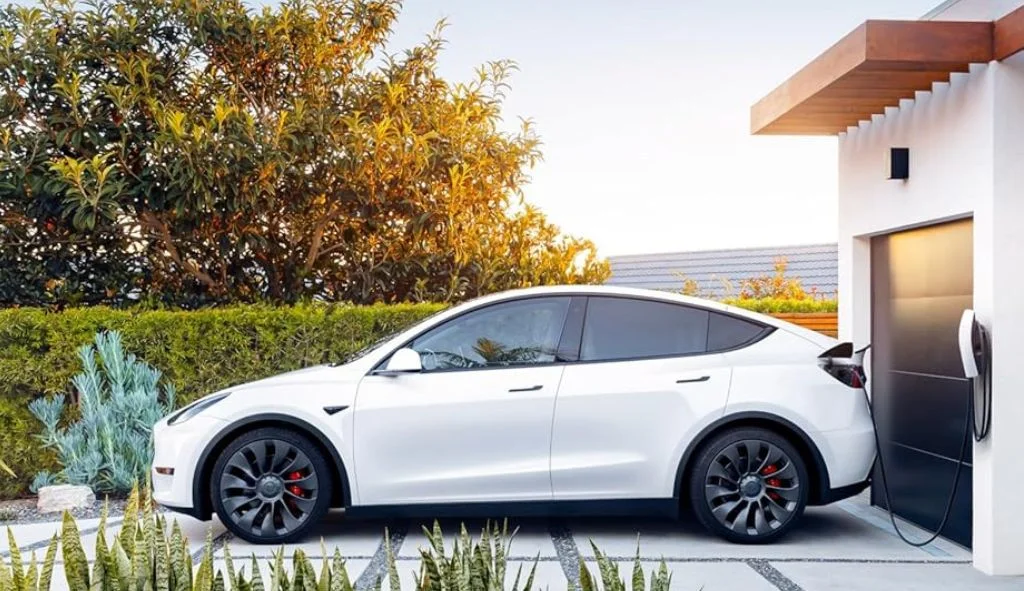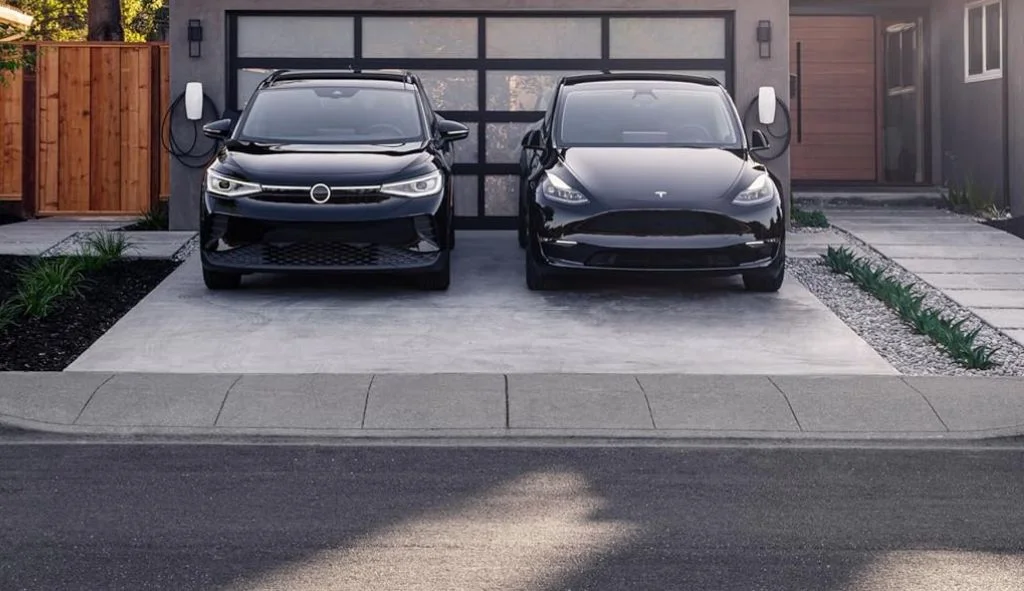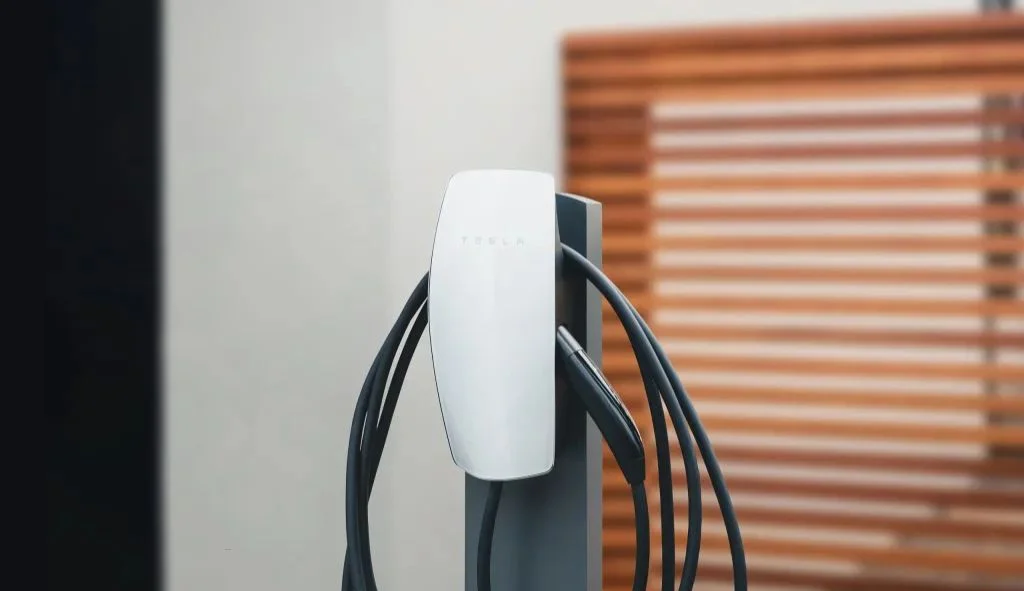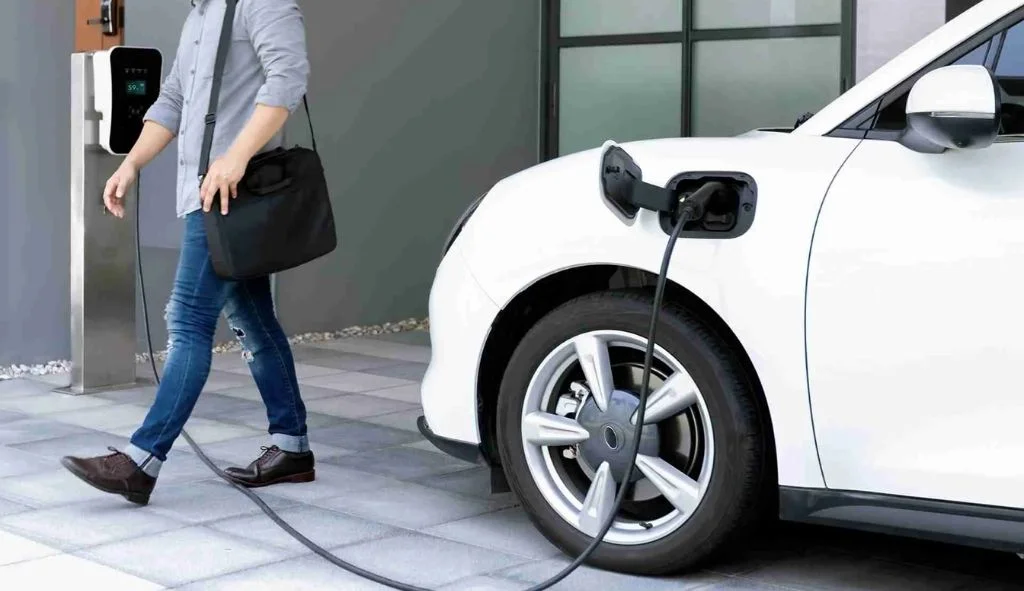The Tesla Wall Connector is best for Tesla-only households, while the Universal Wall Connector works with both Tesla and non-Tesla EVs through its integrated J1772 adapter. Both offer 48-amp charging.
Are you trying to decide between Tesla’s standard Wall Connector and their Universal Wall Connector for your home charging needs? This decision is important since the right charger can significantly impact your daily EV experience. With more electric vehicles hitting the roads and changing connector standards, choosing the right home charging solution has become more complex than ever.
In this comprehensive guide, we’ll examine both options in detail, comparing their features, specifications, compatibility, and real-world performance to help you make an informed decision based on your specific situation.
Understanding Tesla’s Wall Connector Options
Before diving into the detailed comparison, let’s clarify what each of these Tesla charging options actually is and how they fit into the home charging ecosystem.
Tesla Wall Connector (NACS)
The standard Tesla Wall Connector uses Tesla’s North American Charging Standard (NACS) connector, which is designed specifically for Tesla vehicles. This wall-mounted charging unit represents Tesla’s dedicated solution for Tesla owners who want faster home charging than what’s possible with the mobile connector.
The Wall Connector with NACS is a hardwired solution that can deliver up to 48 amps of power (when properly installed with appropriate electrical service). It features a sleek, minimalist design that’s characteristic of Tesla products and integrates seamlessly with the Tesla ecosystem.
Tesla Universal Wall Connector
The Tesla Universal Wall Connector is a newer offering that builds upon the standard Wall Connector’s design but adds versatility through an integrated J1772 adapter. This allows it to charge both Tesla vehicles and non-Tesla EVs without requiring separate adapters.
What makes this solution unique is that the adapter has an electronic locking mechanism, ensuring it can’t go missing – it’s either locked to the connector or stored securely in the body of the unit itself. This design makes it significantly thicker than the standard Wall Connector.
Mobile Connector as an Alternative
While not the focus of this comparison, it’s worth mentioning the Tesla Mobile Connector as an alternative option. This portable charging solution comes with adaptors for standard household outlets and can be used with a NEMA 14-50 adapter for faster charging. At $230, it’s substantially less expensive than either Wall Connector option but offers lower charging speeds (maxing out at 32 amps compared to 48 amps for the Wall Connectors).
Tesla Wall Connector Features and Specifications

Let’s examine the standard Tesla Wall Connector in detail to understand what it offers Tesla owners.
Design and Construction
The Tesla Wall Connector features a sleek, minimalist design with a tempered white glass faceplate. It’s compact and visually appealing, fitting well with modern home aesthetics. The unit includes a lightweight 24-foot charging cable that remains flexible even in cold weather, making it easy to manage.
The connector itself uses Tesla’s NACS standard, which is becoming increasingly prevalent as more manufacturers adopt this connector type. The design is durable and has proven reliable in drop tests and extreme weather conditions.
Charging Capabilities
The standard Wall Connector offers impressive charging performance:
- Maximum output of 11.5 kW / 48 amps
- Delivers up to 44 miles of range per hour of charging
- Customizable power levels to work with various circuit breakers
- Can power share with up to six other Wall Connectors
This level of charging is approximately twenty times faster than a standard household outlet, allowing for complete overnight charging even when batteries are nearly depleted.
Smart Features
The Wall Connector includes several smart features that enhance the charging experience:
- Wi-Fi connectivity (2.4 GHz 802.11 b/g/n)
- Integration with the Tesla mobile app
- Energy usage monitoring
- Over-the-air firmware updates
- Remote service capabilities
- Power sharing functionality for multi-charger setups
These smart features allow users to monitor charging status, track energy consumption, and control charging sessions remotely.
Installation Requirements
The Tesla Wall Connector is a hardwired unit, meaning professional installation is recommended. It requires:
- A dedicated 60-amp circuit for maximum performance
- Professional electrical work to connect to your home’s electrical system
- Compatible with any home electrical system
- Approved for both indoor and outdoor installation
Installation costs vary based on your home’s electrical setup and the complexity of running wiring to your desired location.
Price Point
The standard Tesla Wall Connector is priced at approximately $475, making it more affordable than the Universal version. This price point is competitive within the EV charger market, especially considering the charging speed and smart features offered.
Universal Wall Connector Features and Specifications

Now let’s look at the Universal Wall Connector to understand its offerings and how it differs from the standard model.
Design and Construction
The Universal Wall Connector shares the same basic design aesthetic as the standard model but is noticeably thicker to accommodate the integrated J1772 adapter mechanism. It features the same tempered white glass faceplate and maintains a sleek appearance despite the additional bulk.
Like the standard model, it includes a 24-foot charging cable that performs well in various weather conditions. The Universal Wall Connector has demonstrated excellent durability in testing, passing tests for extreme cold, heat resistance, and physical impacts.
Charging Capabilities
The Universal Wall Connector matches the standard model in terms of charging performance:
- Maximum output of 11.5 kW / 48 amps
- Delivers up to 44 miles of range per hour of charging
- Adjustable current from 12 to 48 amps
- Compatible with power sharing feature for up to six units
There’s no difference in charging speed or efficiency between the two models when charging Tesla vehicles. Both deliver the same amount of power to your car.
Smart Features
The Universal Wall Connector includes all the smart features found in the standard model:
- Wi-Fi connectivity
- Tesla app integration
- Energy usage monitoring
- Over-the-air updates
- Power sharing capabilities
- Optional vehicle access restrictions
One notable difference is that while the unit can be configured to allow or block specific Tesla vehicles from charging, this functionality doesn’t extend to non-Tesla vehicles.
Installation Requirements
Installation requirements are identical to the standard Wall Connector:
- Hardwired installation (no plug-in option available)
- Recommended professional installation
- Requires a dedicated 60-amp circuit for maximum performance
- UL approved for safety
- Rated for indoor and outdoor installation
The installation process and costs are essentially the same for both models.
Price Point
The Universal Wall Connector is priced at approximately $550-$650, depending on the retailer. This represents a $75-$175 premium over the standard Wall Connector, roughly in line with what you’d pay for a standalone adapter.
Key Differences Between the Two Wall Connectors
Now that we’ve examined both options in detail, let’s highlight the key differences to help you decide which is better for your specific needs.
Compatibility with Various EVs
The most significant difference between these two chargers is compatibility:
- Standard Wall Connector: Works natively only with Tesla vehicles. Non-Tesla EVs would require a separate adapter to connect.
- Universal Wall Connector: Works natively with both Tesla vehicles and any EV with a J1772 port thanks to its built-in adapter. The adapter is securely attached to the unit and can’t be lost.
This distinction is particularly important if you own multiple vehicle brands or frequently have visitors with non-Tesla EVs.
The J1772 Adapter Integration
The Universal Wall Connector’s most innovative feature is its integrated J1772 adapter:
- The adapter uses an electronic locking mechanism
- It’s always either locked to the connector or stored in the body of the unit
- This prevents the adapter from being lost or stolen
- The mechanism adds bulk to the unit compared to the standard model
This integration provides convenience for mixed-fleet households or properties where various EVs might need charging.
Size and Design Differences
There are noticeable physical differences between the two units:
- The Universal Wall Connector is significantly thicker than the standard model to accommodate the adapter mechanism
- Both units share the same basic aesthetic with a tempered white glass faceplate
- Both have the same 24-foot cable length
- The standard model has a sleeker, more compact profile
These differences are primarily cosmetic but might matter if space is limited or aesthetics are a priority.
Future-Proofing Considerations
The charging landscape is evolving rapidly, which affects which model might be better for future use:
- Most major automakers have announced plans to switch from J1772 to Tesla’s NACS connector in the 2025-2026 timeframe
- This transition makes the standard Wall Connector potentially more future-proof than it initially appears
- The Universal model offers flexibility during this transition period when both connector types are common
- Having native support for both standards without adapters can be valuable during this multi-year transition
Whether this matters depends on your timeline for vehicle ownership and how quickly connector standardization happens in your region.
Price Comparison
There’s a notable price difference between the two models:
- Standard Wall Connector: Approximately $475
- Universal Wall Connector: Approximately $550-$650
- Price difference: $75-$175
This difference is roughly equivalent to purchasing a separate adapter, making the Universal model a reasonable value if you need both connector types.
Factors to Consider When Choosing
With the key differences established, let’s explore the factors that should influence your decision based on your specific situation.
Your Current and Future Vehicle Plans
One of the most important considerations is what vehicles you currently own and what you plan to purchase in the future:
- If you exclusively own Tesla vehicles and don’t plan to change brands, the standard Wall Connector offers everything you need at a lower price point.
- If you own both Tesla and non-Tesla EVs, the Universal Wall Connector provides convenience without needing separate adapters.
- If you currently own a Tesla but might switch to another brand in the future, the Universal model offers more flexibility, though this is becoming less important as more manufacturers adopt NACS.
Your commitment to the Tesla ecosystem should significantly influence your decision.
Multi-Vehicle Households
Households with multiple EVs have special considerations:
- Both Wall Connector models can power share with up to six units, which is great for homes with multiple Tesla vehicles.
- If you have a mix of Tesla and non-Tesla EVs, the Universal Wall Connector simplifies charging logistics without adapter swapping.
- For multi-car charging, the ability to monitor and manage charging through the Tesla app can help optimize electricity usage.
Consider how many vehicles you need to charge and their varying connector types.
Visitor Charging Needs
If you frequently have visitors with EVs, convenience becomes an important factor:
- The Universal Wall Connector allows any North American EV to charge without bringing adapters.
- The standard Wall Connector would require visitors with non-Tesla vehicles to bring their own adapters.
- As more vehicles adopt NACS, this distinction will become less important over time.
The frequency of non-Tesla visitors needing to charge should factor into your decision.
Climate and Installation Location
Your local climate and installation location can affect which unit is more practical:
- Both units are rated for outdoor installation and perform well in extreme weather conditions.
- In areas with extreme cold, the slim cable design of both units remains more flexible than many competitors.
- For snowy regions, some users worry that adding an adapter might create a potential point of failure, though testing shows the Universal model holds up well in harsh conditions.
- The Universal model’s built-in adapter eliminates concerns about losing or damaging separate adapters in harsh weather.
Your installation location and local climate conditions should be considered when making your choice.
Budget Considerations
Finally, your budget will play a role in the decision:
- If cost is a primary concern, the standard Wall Connector saves you $75-$175 compared to the Universal model.
- Consider whether this price difference is worth the added flexibility of the Universal model.
- Factor in potential future costs if you might need to purchase separate adapters later.
- Installation costs will be similar for both models and typically range from $500-$1500 depending on your electrical setup.
The price difference may or may not be significant relative to the total cost of EV ownership and charging infrastructure.
Real-world Performance and Testing
Beyond specifications, let’s look at how these chargers perform in real-world testing and everyday use.
Charging Speed in Various Conditions
Testing shows that both Wall Connector models deliver consistent charging performance:
- Both units can deliver the full 48 amps / 11.5 kW when properly installed on an appropriate circuit.
- Charging speeds remain consistent regardless of whether using the built-in adapter on the Universal model or the native connector.
- Some users report occasionally slower initial connection times when using the Universal model with certain non-Tesla vehicles, but actual charging speeds are unaffected.
In terms of charging performance, there’s no meaningful difference between the two units when all other factors are equal.
Cold Weather Performance
Cold weather testing has been extensively documented for both units:
- The Universal Wall Connector performed well in freezing conditions, with the cable remaining reasonably flexible even at -11°F (-23.8°C).
- While the cable does stiffen in extreme cold, its thin profile makes it more manageable than many competing chargers.
- The electronic components of both units continue to function properly in freezing temperatures.
- The integrated adapter on the Universal model showed no additional problems in cold weather tests.
Both units are suitable for cold climate regions based on extensive testing.
Heat Resistance
High-temperature performance is equally important:
- The Universal Wall Connector passed heat resistance tests, continuing to deliver maximum power even after reaching 152°F (66°C) during extended charging sessions.
- Neither unit showed any tendency to reduce power output (derate) during hot weather or extended use.
- The thermal management systems in both units appear to work effectively in preventing overheating.
This heat resistance makes both units suitable for hot climate regions or enclosed installation locations.
Durability and Reliability
Durability testing shows both units are well-constructed:
- Drop tests from waist height onto concrete showed no damage to either the NACS connector or the J1772 adapter on the Universal model.
- Both units passed automatic restart tests, resuming charging after power outages without requiring user intervention.
- The locking mechanism on the Universal model’s adapter proved reliable in repeated use tests.
- The 24-foot cable on both units remains durable while being lighter and more flexible than many competing products.
These results suggest both units should provide years of reliable service under normal conditions.
User Experiences
User feedback provides additional insights:
- Tesla owners generally report high satisfaction with both units, praising their reliability and charging speeds.
- Some users of the Universal Wall Connector have reported occasional compatibility issues with specific non-Tesla vehicles, particularly some Rivian models.
- The Tesla app integration receives praise for its user-friendly interface and helpful monitoring features.
- The slim, flexible cable design is consistently mentioned as a significant advantage over bulkier third-party options.
Real-world experiences largely align with the testing results, showing both units perform well in everyday use.
Tesla Wall Charger Gen 3 vs Gen 2
FAQs
Can the standard Tesla Wall Connector charge non-Tesla vehicles?
Yes, but you’ll need a separate adapter. The standard Wall Connector uses Tesla’s NACS connector, which requires an adapter to work with vehicles that have a J1772 port. These adapters typically cost $75-100 and must be stored separately.
Is the Universal Wall Connector worth the extra cost?
It depends on your situation. If you have multiple EV brands or frequently have visitors with non-Tesla EVs, the convenience of the built-in adapter may justify the additional $75-175. If you exclusively use Tesla vehicles, the standard Wall Connector provides identical charging performance at a lower price.
Do both Wall Connectors charge at the same speed?
Yes, both the standard and Universal Wall Connectors deliver the same maximum output of 48 amps / 11.5 kW when properly installed on a 60-amp circuit. This translates to approximately 44 miles of range per hour of charging for most Tesla vehicles.
Can I install these Wall Connectors myself?
While DIY installation is possible if you have electrical experience, Tesla and safety experts recommend professional installation by a licensed electrician. Improper installation could damage your vehicle, charger, or home electrical system and may void warranties or insurance coverage.
Will the standard Wall Connector become obsolete as more cars adopt NACS?
No, the standard Wall Connector is actually becoming more future-proof as the industry moves toward standardization. Most major automakers have announced plans to adopt Tesla’s NACS connector in 2025-2026, which would make the standard Wall Connector compatible with more vehicles without adapters.
Can the Wall Connectors be installed outdoors?
Yes, both the standard and Universal Wall Connectors are rated for indoor and outdoor installation. They are designed to withstand various weather conditions, though they should ideally be protected from direct precipitation when possible.
Can I use multiple Wall Connectors for several vehicles?
Yes, both Wall Connector models support power sharing with up to six units on the same electrical circuit. This allows multiple vehicles to charge simultaneously while intelligently distributing available power based on each vehicle’s needs.
Choosing the Right Tesla Wall Connector for Your Needs
After thoroughly comparing the Tesla Wall Connector and Universal Wall Connector, the decision comes down to your specific circumstances and priorities.
The standard Tesla Wall Connector is the better choice if:
- You exclusively own Tesla vehicles and don’t plan to change
- You prioritize a sleeker, more compact design
- You want to save $75-175 on purchase price
- You rarely need to accommodate non-Tesla vehicles
The Universal Wall Connector makes more sense if:
- You own both Tesla and non-Tesla electric vehicles
- You frequently have visitors with different EV brands
- You value the convenience of not dealing with separate adapters
- You want maximum flexibility during the industry’s transition to NACS
Both products offer the same charging performance, smart features, and build quality. The main differences are compatibility, physical size, and price. With proper installation, either option will provide reliable, fast charging for your electric vehicle for years to come.


